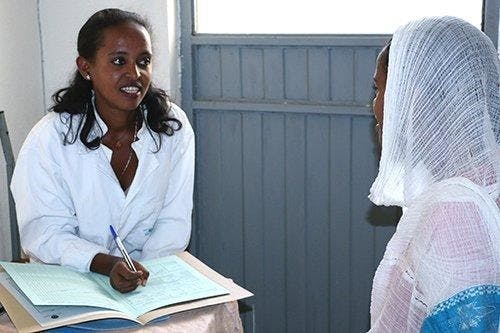Midwife Selamawit Giday and a crowd of maternal health workers are gathered around a wall at the local clinic in rural Adwa in Ethiopia’s far north.
They’re watching arrows dart across anatomical charts projected onto its surface. The images come from a palm-sized, solar-powered smart projector that is helping save lives by teaching local midwives skills and information. Developed by the United Nations Population Fund (UNFPA), this portable “Mobile Learning System” is reaching communities in the country’s hardest-to-reach areas, where electricity is often unreliable.
Ethiopia has one of the highest rates of maternal mortality in the world. In the fight to stop women from dying in childbirth, knowledge is power. Through UNFPA’s mobile tool, Selamawit and other health workers in remote areas have been given access to information that can save lives, ranging from strengthening newborn care to addressing childbirth complications and family planning.
Expanding access to lifesaving training
Selamawit is one of many local health workers who have taken part in a UNFPA case study designed to test the portable MLS, as the mobile training device is known. Throughout Ethiopia and Tanzania, 22 health centers and midwifery training sites are using the technology with the hope that the new device will expand access to medical information and training for maternal health care workers, midwives, local families, and community leaders. The tool has also been launched in the Rutsiro province of Rwanda.
“Midwives often go beyond their call of duty,” says Bettina Maas, UNFPA Country Representative for Ethiopia. “Often working long hours in difficult, resource-poor environments, with little equipment and no supervision, they have to complete multiple tasks that would typically be undertaken by teams. This is why alternative and innovative solutions are essential for midwives to be able to upgrade their skills.”
If maternal health workers or midwives in remote areas want to learn new skills or take a refresher course, they often have to leave their homes and go to a major city for training. For example, if Selamawit needed to journey to Ethiopia’s capital of Addis Ababa for a training, she would have to travel over 1,000 kilometers by road, taking her far away from her clinic in Adwa.
“Midwives are dealing with life or death situations,” remarks Aster Berhe, Country Midwife Advisor at UNFPA Ethiopia. “But it’s not so easy for midwives to fit in formal training on managing life-threatening complications related to pregnancy or childbirth, thus making the Mobile Learning System all the more relevant.”
Using knowledge to combat maternal mortality
Despite some progress since 1990, maternal mortality remains unacceptably high around the world: More than 300,000 women die every year from mostly preventable complications of pregnancy and childbirth. Through the Sustainable Development Goals, world leaders have committed to reducing maternal deaths to less than 70 per 100,000 live births by 2030. Much more progress is needed to reach this target.
UNFPA and partners realized new solutions would be needed to make sure women get the care they need, especially in the world’s most remote areas. This is where the portable MLS comes in. Since 2016, the tool has helped train around 5,000 midwives, health care workers, and individuals.

Cost-effective solutions to improve training
UNFPA, in partnership with the World Health Organization and Jhpiego, an international health non-profit affiliated with Johns Hopkins University, developed health lessons that provide skills and meet international clinical guidelines. The lessons are delivered through the mobile devices, which are both solar-powered and WiFi-enabled, so they can still function when access to electricity or the internet is erratic.
Gebreamlak Giday, an instructor at the midwifery department of Axum University in northern Ethiopia, helped pilot the mobile learning system in 2016. He told UNFPA that the tool has supported health workers in remote areas and improved the quality of the education for midwifery students since it allows for a variety of teaching methodologies.
The learning system was designed to include expertise from local and global partners – including the Ministry of Health in Ethiopia, the Ethiopian Midwives Association, and similar organizations in Tanzania. These partnerships were brokered by UNFPA at the country-level to ensure that the solution was tailored to local contexts while providing standardized UN-endorsed material. Internally, UNFPA brought together maternal health experts with IT specialists to make sure the technology is both educational and workable.
Governments and midwife associations have also been valuable partners in the distribution of the platform, hosting recruitments and trainings so local stakeholders can learn about the opportunities.
“Today, with rapidly expanding broadband penetration and the costs of hardware like computers, tablets, and projectors rapidly declining, technology offers cost-effective solutions to improve training of health care providers,” says Geeta Lal, Global Midwifery Coordinator with UNFPA. “But it is important that the solution selected is simple and that it can be owned and applied by the local authorities and communities to improve health care outcomes.”

Selamawit Giday says that the trainings have helped her to improve hard skills, like her ability to manage childbirth complications, as well as soft skills, such as bedside manner and birth coaching. UNFPA has added guidelines around patient care to the midwife trainings to increase awareness of the importance of sensitive and respectful maternal health care.
Sylvia Wong, UNFPA’s Innovation Coordinator, believes that this is part of the unique value the UN agency brings to a project like this: “In theory, we can potentially introduce different technologies or more portable learning devices, but if they’re not being introduced from the human rights lens of what the women in their communities want, then that would pose challenges. UNFPA is staffed by national or local staff who know their communities, who know their issues.”
What is next for this solution?
In the near-term, UNFPA will continue to work with partners such as the government of Canada and Johnson & Johnson to scale up implementation of the portable MLS across Tanzania and Ethiopia, as well as bring it to countries facing similar health care issues, such as Nepal, Somalia, South Sudan, Zambia, and Zimbabwe. It is also being rolled out in Rwanda with the Ministry of Health. IT specialists will also continue to improve the technology, developing cheaper, more efficient models with more resourceful solar panels.
In the long-term, UNFPA’s Sylvia Wong hopes that the organization will use the lessons from these case studies to adapt to new challenges and technological opportunities. She says, “What I would love to see is that what we learn from this project can help open new thinking and approaches that train and support midwives even more.”
Want to learn more about how the UN is innovating to improve lives? Sign up to be a champion of innovation.
Innovation in Action shares the stories of how the UN is working with partners to pilot, test, and scale new ideas and new ways of working to deliver better results for people on the ground. From using artificial intelligence to better understand peoples’ needs to innovative methods to reduce maternal and infant mortality to reimagined partnerships and new approaches to mediation, the UN is working across issues and sectors to create dynamic and impactful solutions. The series has been developed with input and support from the UN, including the UN Innovation Network.



 View All Blog Posts
View All Blog Posts

